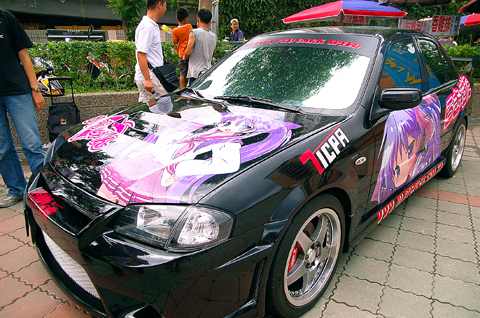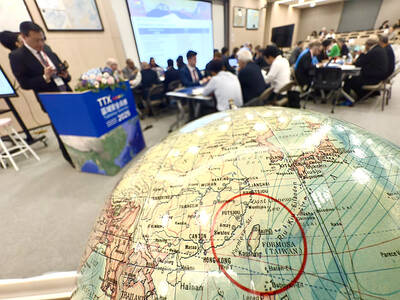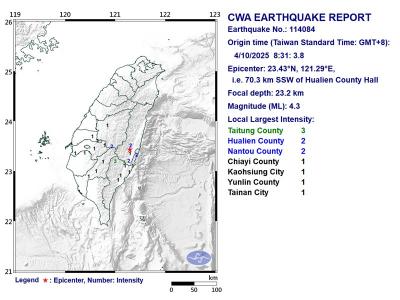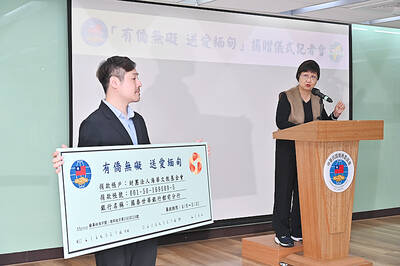If you happen to see cars or scooters on streets bearing images of cartoons, manga or online computer game characters, it’s quite possible that the driver is a fan of itasya (痛車).
Itasya is a Japanese term referring to cars decorated with cartoon or manga images on the outside — a subculture that has been popular in Japan for the past decade.
A fan of Japanese manga and itasya, 28-year-old Liu Chien-liang (劉建良) founded the Taiwan Itasya Culture Promotion Association in February with a few friends.

PHOTO: HSIEH WEN-HUA, TAIPEI TIMES
SEVEN EXAMPLES
At the moment, there are seven itasya in Taipei, Kaohsiung and Tainan, including Liu’s own itasya with “Kokagami,” a character from the manga Lucky Star on the doors, hood and roof.
It took him three attempts before Liu managed to paste Kokagami’s images onto his car.
Liu said that he’s very attracted to Kokagami because she looks cold outside, but is actually just shy on the inside.
WHAT’S IN A NAME?
He said it makes him proud when he drives in the car because it makes him the focus on the road.
The term itasya comes from the Japanese word ita (痛), which means “to hurt” or “painful,” while sya (車) means “car.”
As for why an itasya is called an itasya, Liu said that there are three different explanations.
The first goes that, under Japanese traffic regulations, one has to pay extra fees to put exotic decorations on the outside of a car, and thus it “hurts” to pay the extra money.
The second explanation says that itasya is how the Japanese calls Italian cars, and since they believe Italian cars to be the best decorated ones, the Japanese then chose to call cars decorated with manga characters’ pictures itasya.
The third explanation, Liu said, goes that since the rich decorations on itasya are so colorful, they would “hurt” viewers’ eyes.

Taiwan is stepping up plans to create self-sufficient supply chains for combat drones and increase foreign orders from the US to counter China’s numerical superiority, a defense official said on Saturday. Commenting on condition of anonymity, the official said the nation’s armed forces are in agreement with US Admiral Samuel Paparo’s assessment that Taiwan’s military must be prepared to turn the nation’s waters into a “hellscape” for the Chinese People’s Liberation Army (PLA). Paparo, the commander of the US Indo-Pacific Command, reiterated the concept during a Congressional hearing in Washington on Wednesday. He first coined the term in a security conference last

DEFENSE: The National Security Bureau promised to expand communication and intelligence cooperation with global partners and enhance its strategic analytical skills China has not only increased military exercises and “gray zone” tactics against Taiwan this year, but also continues to recruit military personnel for espionage, the National Security Bureau (NSB) said yesterday in a report to the Legislative Yuan. The bureau submitted the report ahead of NSB Director-General Tsai Ming-yen’s (蔡明彥) appearance before the Foreign and National Defense Committee today. Last year, the Chinese People’s Liberation Army (PLA) conducted “Joint Sword-2024A and B” military exercises targeting Taiwan and carried out 40 combat readiness patrols, the bureau said. In addition, Chinese military aircraft entered Taiwan’s airspace 3,070 times last year, up about

A magnitude 4.3 earthquake struck eastern Taiwan's Hualien County at 8:31am today, according to the Central Weather Administration (CWA). The epicenter of the temblor was located in Hualien County, about 70.3 kilometers south southwest of Hualien County Hall, at a depth of 23.2km, according to the administration. There were no immediate reports of damage resulting from the quake. The earthquake's intensity, which gauges the actual effect of a temblor, was highest in Taitung County, where it measured 3 on Taiwan's 7-tier intensity scale. The quake also measured an intensity of 2 in Hualien and Nantou counties, the CWA said.

The Overseas Community Affairs Council (OCAC) yesterday announced a fundraising campaign to support survivors of the magnitude 7.7 earthquake that struck Myanmar on March 28, with two prayer events scheduled in Taipei and Taichung later this week. “While initial rescue operations have concluded [in Myanmar], many survivors are now facing increasingly difficult living conditions,” OCAC Minister Hsu Chia-ching (徐佳青) told a news conference in Taipei. The fundraising campaign, which runs through May 31, is focused on supporting the reconstruction of damaged overseas compatriot schools, assisting students from Myanmar in Taiwan, and providing essential items, such as drinking water, food and medical supplies,